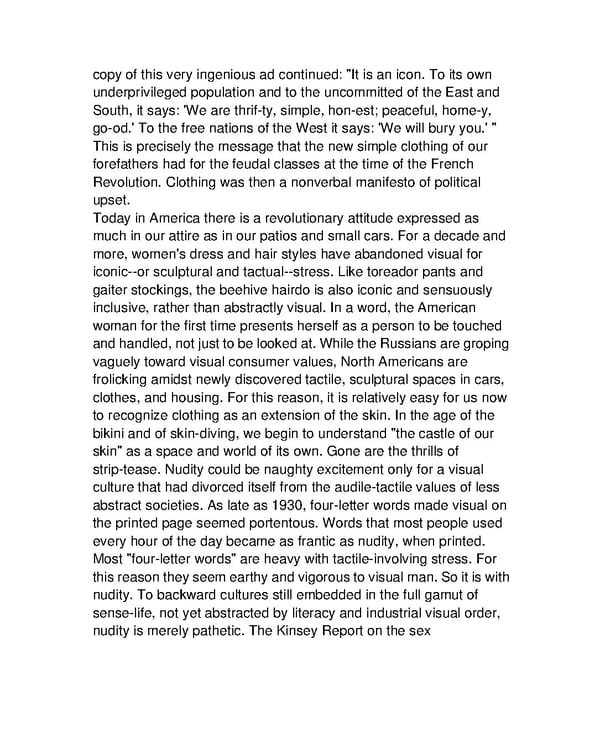copy of this very ingenious ad continued: "It is an icon. To its own underprivileged population and to the uncommitted of the East and South, it says: 'We are thrif-ty, simple, hon-est; peaceful, home-y, go-od.' To the free nations of the West it says: 'We will bury you.' " This is precisely the message that the new simple clothing of our forefathers had for the feudal classes at the time of the French Revolution. Clothing was then a nonverbal manifesto of political upset. Today in America there is a revolutionary attitude expressed as much in our attire as in our patios and small cars. For a decade and more, women's dress and hair styles have abandoned visual for iconic--or sculptural and tactual--stress. Like toreador pants and gaiter stockings, the beehive hairdo is also iconic and sensuously inclusive, rather than abstractly visual. In a word, the American woman for the first time presents herself as a person to be touched and handled, not just to be looked at. While the Russians are groping vaguely toward visual consumer values, North Americans are frolicking amidst newly discovered tactile, sculptural spaces in cars, clothes, and housing. For this reason, it is relatively easy for us now to recognize clothing as an extension of the skin. In the age of the bikini and of skin-diving, we begin to understand "the castle of our skin" as a space and world of its own. Gone are the thrills of strip-tease. Nudity could be naughty excitement only for a visual culture that had divorced itself from the audile-tactile values of less abstract societies. As late as 1930, four-letter words made visual on the printed page seemed portentous. Words that most people used every hour of the day became as frantic as nudity, when printed. Most "four-letter words" are heavy with tactile-involving stress. For this reason they seem earthy and vigorous to visual man. So it is with nudity. To backward cultures still embedded in the full gamut of sense-life, not yet abstracted by literacy and industrial visual order, nudity is merely pathetic. The Kinsey Report on the sex
 Understanding Media by Marshall McLuhan Page 135 Page 137
Understanding Media by Marshall McLuhan Page 135 Page 137